How do I get these Led Arcade buttons to light up?
-
@retroprogrammer You need a 5V source from somewhere - how is your project configured? What does the design look like? How is it powered? See https://retropie.org.uk/forum/topic/3/read-this-first.
In my project, I use separate power supplies for LED lighting, Sound System and Pi. To power those LEDs you will need a power supply. Each LED needs 25mA. They will all be permenantly on when powered. If you want flashing and effects, you will need a controller. Check out the heatsinks - 10 LEDs on = 0.25A so 500mA for 20. A proper power source is needed.
-
I have virtually identical buttons to those, but my USB encoder is designed to illuminate them - it comes with three pin connectors and a wire harness that connects to all 4 tabs, like the one in the link below.
https://www.amazon.com/EG-STARTS-Encoder-Joystick-Controller/dp/B0776NFW4M/ref=sr_1_3?ie=UTF8&qid=1524753584&sr=8-3&keywords=led+usb+encoder+zero+delay&dpID=51drBt5js8L&preST=SY300_QL70&dpSrc=srch
-
why not use the 2 red connectors on your encoder? 5V DC
-
@dorkvonwaterfall said in How do I get these Led Arcade buttons to light up?:
Why not use the 2 red connectors on your encoder? 5V DC
Current. You might have enough depending on the number of LEDs but the Pi will struggle to run properly if you are powering them all in parallel from that connector which itself is connected to the USB of a Pi.
-
@rbaker i stand corrected...
although i use them on my config, but only 3 small LED buttons (3,3V with a resistor, cant remember the value))
-
There are a lot of different ways to solve this.
As was mentioned already you could;
- replace your usb encoder with an led 3 pin encoder board. (1 pin is button action +, 1 is +5v for led and 1 is ground) Those connectors have a mini daisy connecting the ground of the button and led to the same ground pin of the connector.
- you may have power draw issues that slow down the Pi if you power a lot of leds. I didn't really notice an issue in a build I did with 10 led buttons on each players, but to be safe i brought in a powered usb hub to ensure the Pi was not impacted.
- Build a daisy chained wire harness to connect to the +5v connector on your existing board. This will power the led portion of the buttons (which by the way are the other two pins on the image you included). You will need to determine which pin on the connector is power and which ground. You can create a daisy chain harness with spade connectors that will slip onto the led pins like the button spade in your image do.
- again power draw may be an issue on the PI and the same powered usb hub solution applies.
- power the leds independently. In this solution you are still creating a daisy chain wire harness for the LED pins but instead of connecting them to the +5v connector on the usb board you would be wiring them to a 5 volt power adapter that you plug in or something similar.
These are the three main solutions and they all have an unspoken given of all leds lights are just on. No fancy programming based on action buttons for game selected or LED activating only when button pressed. I am also leaving off the solar power, potato power, or pedal power possibilities.
What I will say as an aside that I find worth doing is what ever power connection method you use. to add a small toggle switch to the ground so you can, if you ever feel like it, turn off the leds without effecting the buttons ability to function.
The lights are cool, but sometimes its nice to have them off for a while.
-
Thanks everyone for the reply's, @Lurker I will probably use the 2nd or 3rd option as I am to lazy to buy a USB encoder. Thanks again guys :)
-
@Lurker also if I went with the 2nd option, how would I make a daisy chain for this arcade build, or even how do I make a daisy chain in the first place?
-
It is not very difficult and you can do it without soldering, but you will need to buy some raw material to work with.
You will need:
wire
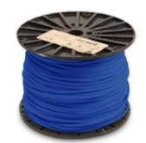
some people salvage Cat5 wire. It can be useful particularly if you want to set up connection ports to plug and unplug equipment, but it is also delicate. Probably the thinnest wire you would want to work with. And if using Cat5 wire I would solder it to make sure it does not pull free.You can buy a spool of way more than you need pretty cheap in various gauges. I would draw the line at 18 gauge though. For these button wires 18 gauge is thin enough to work but thick enough to not bend out of the way well.
Colors are up to you but they will help spot which is which IF you are consistent.
My Die Hard explosives have no red or blue wire just various shades of pink. "McClane move the dusty rose aside, crimp the bubble gum pink and then cut the blush pink wire." "NO!!! not the fuscia!!" BOOM... "Muha ha ha"Female Spade connectors
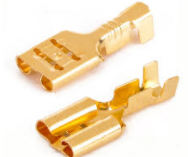
2.8mm or 4.6mm I can't remember which off the top of my head but measure the width of a pin and it will tell you which one.
You can get the variety sets online as well.JST connector
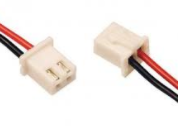
This is the part that connects to the usb board. check the size before you order online as the little 1.25mm look just like the larger ones you need. The number in this case is the distance between the two pins on the usb board connectors. Again 2mm something I think.You only need one or two but it is easier and cheaper to get a 10-20 set online.
These will usually come with lead wire but you can get them on their own if you really want to build your own. The little contacts these use definitely need to be soldered to hold correctly which is why they often come with leads.
Wire Crimper/stripper
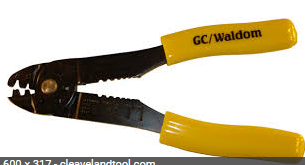
Not critical but it does make cutting the wire, stripping the ends and crimping the spade down easier and all in one tool.
"But wait there's more!...huh?...oh. I'm being told there isn't more. That is all they do. Cut, Strip or Crimp"The set up.
Cut a length of wire (long enough to connect to the JST connector and the USB board later).
Strip the end of the length you cut and the end of wire on the spool.
twist both together and set in the end of the spade.
(IF you want to use the little rubber covers you will slide them over the wire before you put on the spade and then slide them over the spade after it is crimped) I always forget and thus hate this part. I hate it so very much
Crimp down the edges so both wires are held down by the spade end. (You can solder this for a stronger connection but not required IF you crimp it well enough)
With the wire still connected to the spool run out enough wire to reach the next button with a little slack and repeat the process for as many buttons as you want to chain together.
The end result will look like this:
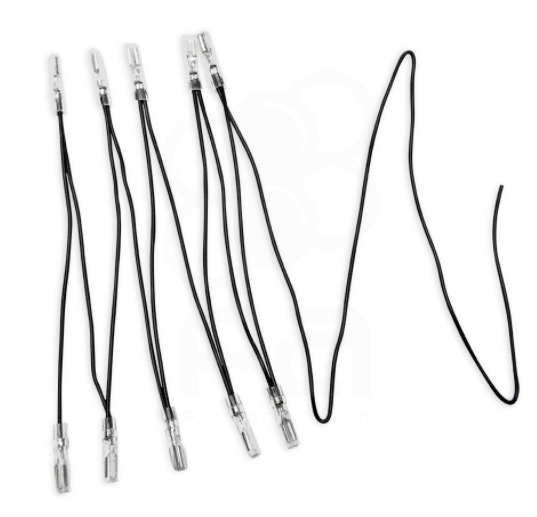
You will create a chain for both pins of the JST connector (IE one for +5 volts and one for ground)
PRO TIP
add an on/off toggle switch to the ground daisy chain and you can control the lights independent of everything else.
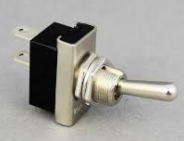
Lastly you will connect the loose end of each chaig to one of the wires of the JST connector so they can connect to the USB board. Whether you solder or rig on another spade connection with a male and female spade is up to your skill level.
Be sure to test which pin on the USB board is ground and which is the 5volt so you get it correct on the LED pins.
Measure with a volt meter or trail and error on one button.You can power all the LEDs of Player 1 and 2 off one USB board by making one long chain with + and ground. Or you can make a daisy chain for each player connected to each player's USB board. That's up to you.
-
If you want to get really fancy, there is a great tutorial here https://andrewdupont.net/2017/06/26/nostalgia-tron-part-7-led-control/ on how to control the leds individually. The guy who created it has a system set up that will only illuminate the buttons that work on a particular game, including the software hacks. It's on my list of things to do once my cabinet is fully up and running.
-
@douga haven’t read your link. But there’s a program called LED blinky that will do the same thing. Works great with my Hyperspin setup.
Edit: should have read fast but didn’t think i was going to be sitting here so long. 😁
That is a great write up and I wish I would have had such an in-depth article to follow back in the day.
-
@chuckyp
Yeah, the whole 11 article write-up is excellent. I plan to implement a few of his less obvious details when I get to the end of the basic stuff. I especially like the way to power up and down the rest of the components when the Pi boots up/shuts down. -
@DougA will this work with my button controller though?
-
I am thinking of making my Led buttons to work with a arduino like this video:
-
@retroprogrammer
Yes. You would use your current usb encoder with the connections for the button itself, and the led connectors would connect to the other interface. That is basically what is done with the setup,shown in the link - buttons through the I-PAC and leds through the other interface. -
I'm using a Pac-Drive from Ultimarc for my LED buttons. @savetheclocktowr made a controller software for some nice sequencing effects. It's not needed for permanent lighting, the Pac-Drive will do that out-of-the-box in Retropie.
Contributions to the project are always appreciated, so if you would like to support us with a donation you can do so here.
Hosting provided by Mythic-Beasts. See the Hosting Information page for more information.